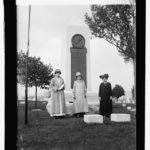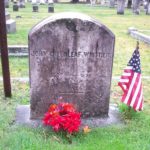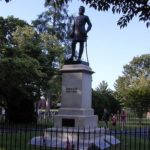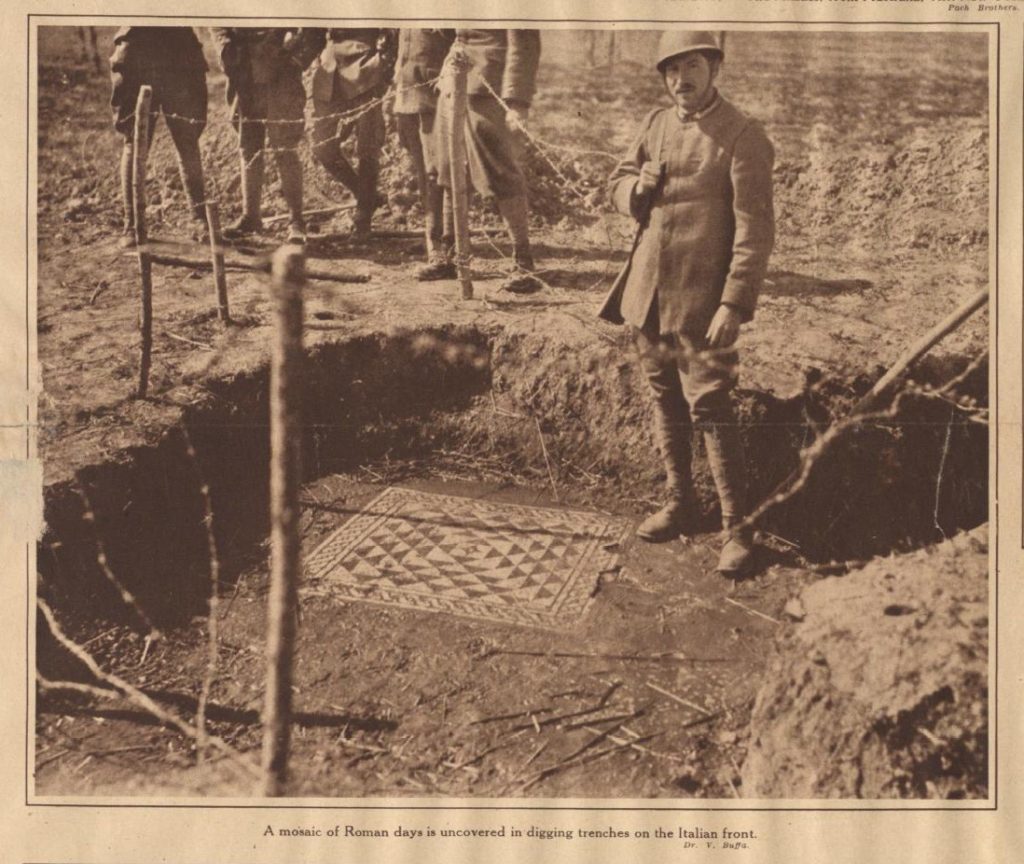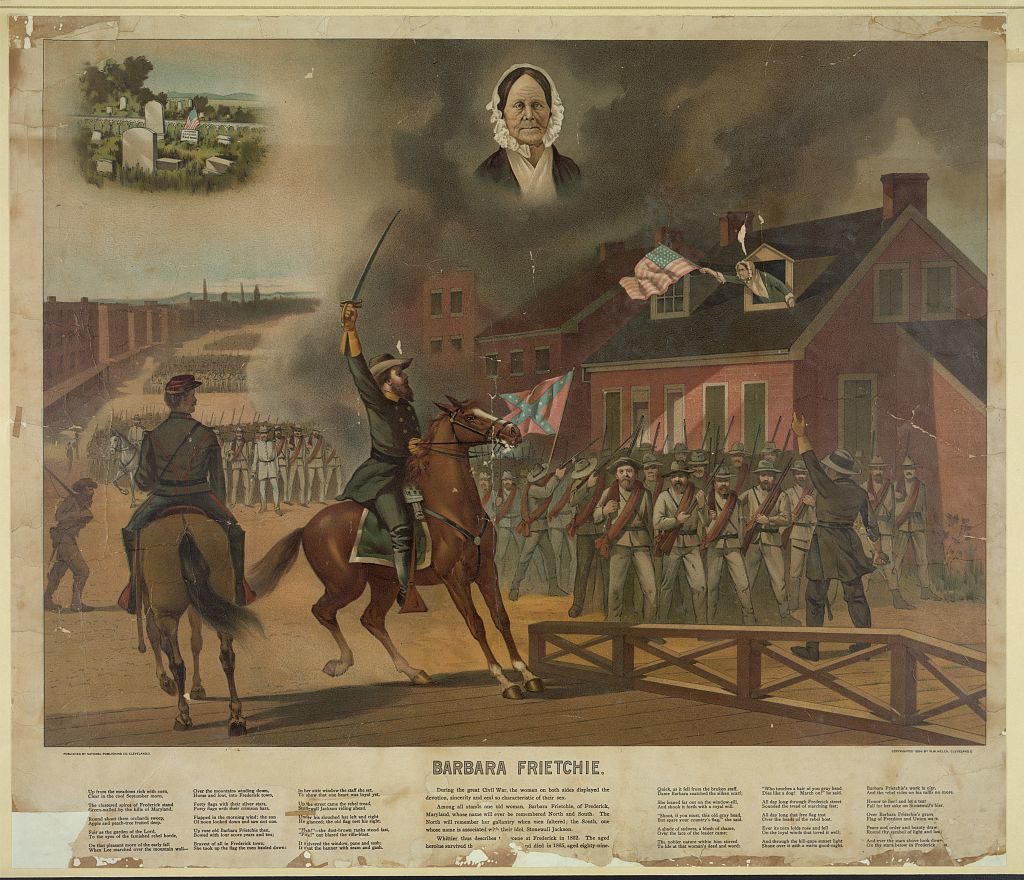An editorial in the April 25, 1868 issue of Harper’s Weekly lamented all the historic Revolutionary War era structures that were being left to deteriorate and hoped that three other “sacred” buildings could be preserved. One of those structures related to the Antietam campaign of September 1862, particularly as the Confederate army was marching through the streets of Frederick, Maryland. (from the Internet Archive Harper’s pages 269-270):
HISTORIC HOUSES.
All over the country there are going up every year numerous monuments, like that which we illustrate on the preceding page, designed to commemorate the names of those who fell in the war for the suppression of the rebellion, and which in time will become hallowed and historic structures. There are also extant in various parts of the country a few historic structures of a past ago. Unfortunately they are not numerous now, and it is our shame that these few are badly preserved and illy cared for. Each year sees the demolition of or changes in some one or more of these buildings, and it is to be feared that many of them will soon entirely disappear. We give in this issue of the Weekly engravings of three houses which have an historic interest, and which ought to become more sacred as they decay, but which will doubtless – at least we fear will – share the fate of the Revolutionary houses and monuments whose neglect we [depre?nt?] in vain, and many of which are already past recovery. The first of these which we notice is the
ANCIENT FRIENDS’ MEETING-HOUSE. …
HOUSE OF BARBARA FRIETCHIE.
The story of BARBARA FRIETCHIE has been made familiar, by the stirring poem of WHITTIER, to every school-boy in the land. It will be remembered that from the house of this fearless old lady the only Union flag in Frederic, Maryland, was found flying by STONEWALL JACKSON on his entry into that city in the invasion of 1862. The poem by WHITTIER has been published in full in the Weekly, and is now declaimed in every school at the North, but there are lines in the following passage from it which will be interesting in this connection:
Forty flags with their silver stars,
Forty flags with their crimson bars,
Flapped in the morning wind: the sun
Of noon looked down, and saw not one.
Up rose old Barbara Frietchie then,
Bowed with her fourscore years and ten;
Bravest of all in Frederick town,
She took up the flag the men hauled down;
In her attic window the staff she set,
To show that one heart was loyal yet.
Up the street came the rebel tread,
Stonewall Jackson riding ahead.
Under his slouched hat left and right
He glanced: the old flag met his sight.
“Halt!”— the dust-brown ranks stood fast.
“Fire!”— out blazed the rifle-blast.
It shivered the window, pane and sash;
It rent the banner with seam and gash.
Dame Barbara snatched the silken scarf;
She leaned far out on the window-sill,
And shook it forth with a royal will.
“Shoot, if you must, this old gray head,
But spare your country’s flag,” she said.
A shade of sadness, a blush of shame,
Over the face of the leader came;
The nobler nature within him stirred
To life at that woman’s deed and word:
“Who touches a hair of yon gray head
Dies like a dog! March on!” he said.
All day long through Frederick street
Sounded the tread of marching feet:
All day long that free flag tost
Over the heads of the rebel host.
THADDEUS STEVENS’S DWELLING. …
150 years later we know that Barbara Fritchie was undoubtedly a Unionist who lived in Frederick but probably didn’t confront the rebels with the Union flag. A couple interesting newspaper articles published during the the Civil War Sesquicentennial discussed the poem’s authenticity. According to The Frederick News-Post John Greenleaf Whittier probably based his poem on a letter he received from Eden Southworth, a fiction writer from Georgetown. Even if Barbara didn’t do it, there were three other women who might have waved the Union flag in view of the Confederates. The Washington Post mentioned only one of the three – Mary Quantrell, who “held up the Stars and Stripes on her porch while Confederate soldiers tramped down Patrick Street, according to seven witnesses cited in a book by a Frederick resident who respected Fritchie but wanted to get the story right. Quantrell had a verbal altercation with a Confederate officer, who was probably Gen. A.P. Hill rather than the better-known Jackson.” Barbara Friethcie also lived on Patrick Street. One difficulty with fact-checking the poem was that both Mrs. Frietchie and Stonewall Jackson had died by the time the poem was published in the October 1863 issue of The Atlantic MonthlyPreservation of the original house didn’t work out too well, but apparently not because it gracefully deteriorated into shambles. It was possibly damaged by a flood in 1868. According to the Barbara Fritchie House website, “The tidy Cape Cod house from which she is said to have raised the flag was torn down in 1869 and reconstructed in 1927 from photos and documents of the original early 1800’s home.” The reconstructed house still stands. For some time it served as a museum; recently the home was purchased to be remodeled and converted to an Airbnb.
At least one school boy declaimed “Barbara Frietchie” over a century later. My memory is that I presented the poem, which I think I found in an old blue book, to my 8th grade English class and included background music. I think I recorded an appropriate Henry Mancini tune over the air from the family hi-fi to my cassette tape recorder. Thanks to a little more modern technology and some investigation with Google, Amazon, and Youtube, I’m pretty sure the album was Debut! Henry Mancini Conducting the First Recording of the Philadelphia Orchestra Pops and the song might have been “Drummers’ Delight.” I’m not 100% sure about that, but I doubt even I would have picked “The Ballerina’s Dream.”
I dug a little deeper. Now I’m quite certain I found the poem in Prose and Poetry for the Seventh Year published in 1925. According to the book John Greenleaf Whittier explained at one time how he understood the actual facts on the ground in Frederick:
Whittier issued a statement concerning the incident told in the poem. “It is admitted by all that Barbara Frietchie was no myth, but a worthy and highly esteemed gentle woman, intensely loyal and a hater of the Slavery Rebellion, holding her Union flag sacred, and keeping it with her Bible; that when the Confederates halted before her house and entered her door yard, she denounced them in vigorous language, shook her cane in their faces, and drove them out; and when General Burnside’s troops followed close upon Jackson’s, she waved her flag and cheered them. It is stated that May [sic] Quantrell, a brave and loyal lady in another part of the city, did wave her flag in sight of the Confederates. It is possible that there has been a blending of the two incidents.”[1]
Thanks to a preservation and dissemination effort at the Library of Congress you can listen to a professional declaimer almost 50 years after the Frederick incident. Frank Burbeck recorded the poem on May 3, 1912. There isn’t any background music, but there is a good deal of reassuringly authentic sounding scratches and crackles. I’m pretty sure it’s OK to listen to it here, but you can always visit the
Library to hear it.
From the perspective of 150 years later Harper’s didn’t seem very curious about the accuracy of the story told in the poem. Of course, there were certainly many Unionists in the border state of Maryland; Barbara Frietchie and her house were real. Apparently Mr. Whittier, a well-known poet and abolitionist, believed his correspondent’s story, at least at first.
And also from the perspective of 150 years, does the poem’s content seem a bit dated? Standing up for the American flag? Sympathizing with a slave-owning rebel general? That would be one thing the general and the widow had in common – at least as late as the 1860 census Mrs. Frietchie also owned one or two slaves (see the link to the Frederick newspaper article above).
__________________________________________________
I’ve read that war technology is often adapted for beneficial civilian use. A photo from 100 years ago suggests that World War I’s trench warfare was also a boon to archaeology as soldiers uncovered an example of some real long term historic preservation. I don’t know anything about this particular mosaic, but I wouldn’t want to have bet that it survived the last six or seven months of the war.
__________________________________________________
Getting back to Mrs. Fritchie, you can read another explanation by John Greenleaf Wittier at CivilWarHome, but there is mention of one of his writings on the topic being on March 7, 1862, which would be absolutely amazing if true.
Is there anything at all straightforward about the Barbara Fritchie story? It doesn’t surprise me that John Greenleaf Whittier assumed a 95 year old would have gray hair, but her hair in the photograph from the Library of Congress sure doesn’t look that gray, unless it’s a real dark gray. Somebody wanted her picture taken a year before the poem made her famous. Also from the Library: a grayer head; her home ca.1870; her relics dated 1885; her grave in 1925; the mosaic published in the “Graphic” section (image 2) of the May 12, 1918 issue of the New York Tribune; the tableau probably from 1896.
According to Wikipedia the photo of the Confederate troops in Frederick is from Historical Society of Frederick County, Maryland. Photographs licensed under Creative Commons: the reconstructed house by Muhranoff from 2015; Mr. Whittier’s grave in the Union Cemetery, Amesbury, MA by Midnightdreary from 2009; Stonewall’s statue at his current grave site at Jackson Memorial Cemetary, Lexington, Va. by Edward Valentine from possibly 2002.
Here’s a definition by Alexis de Toqueville from a translation by Henry Reeve at Project Gutenberg:
In my opinion, poetry is the search and the delineation of the ideal. The poet is he who, by suppressing a part of what exists, by adding some imaginary touches to the picture, and by combining certain real circumstances, but which do not in fact concurrently happen, completes and extends the work of nature. Thus the object of poetry is not to represent what is true, but to adorn it, and to present to the mind some loftier imagery.
I’ll try to keep that in mind
- [1]Avery, Fannie, L., Mary M. Van Arsdale, and D. Emma Wilber, editors. Prose and Poetry for the Seventh Year. Syracuse, New York: The L.W. Singer Company, 1925. Print. page 458.↩

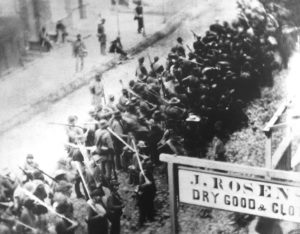
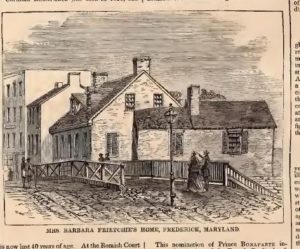
![Barbara Frietchie / photographed by Brady & Co., 352 Penna. Ave., Washington, for the Great National Fair. ([1862?, printed 1863 or 1864] ; LOC: https://www.loc.gov/item/2005677232/)](https://www.bluegrayreview.com/wp-content/uploads/2018/05/07770v-182x300.jpg)
![[Barbara Fritchie waving tattered U.S. flag from window. Frederick, Md., Sept. 1862] (c.1922; LOC: https://www.loc.gov/item/2005678040/)](https://www.bluegrayreview.com/wp-content/uploads/2018/05/3b05599r-229x300.jpg)
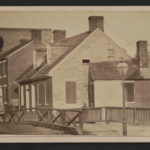
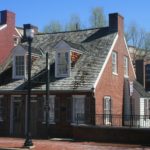
![Barbara Frietchie relics ([1885]; LOC: https://www.loc.gov/item/2017650452/)](https://www.bluegrayreview.com/wp-content/uploads/2018/05/1s08535v-150x150.jpg)
